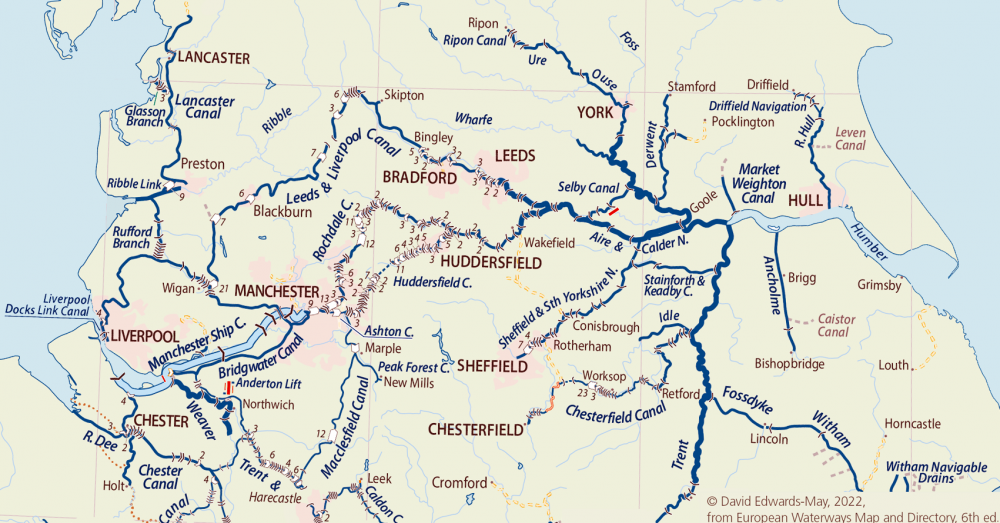Northern canals map (click to open)
The Lancaster Canal
- Boat length : 72’ or 21.95m
- Boat width : 14’ or 4.27m
- Draft : 3’ or 0.91m
- Headroom : 8’2” or 2.44m
Preparation for the construction of the canal began in 1772 and Royal Assent was given for the works to begin 20 years later. Originally built from Wigan to Kendall, the southern reaches were separated off to form part of the Leeds Liverpool canal and after spending most of its existence cut off from the rest of the network, the Lancaster developed a character of its own, enhanced by the fact that it is the only coastal canal in the country, now linking Preston with Kendal over one of the prettiest 41 mile stretches that you could hope to cruise along – and there are no locks, which makes life easy.
In 2002 the Canals and Rivers Trust connected it to the rest of the network via the Rivers Ribble and Douglas back to the Leeds and Liverpool canal, opening up its potential and increasing its appeal. (Please note that it is necessary to book your passage in advance if you are planning to use the Ribble Link).
Cruising highlights along the canal include the Lune aqueduct, which was completed in 1794 and swoops an astonishing 62 feet across the River Lune. There are other delights on hand – your route will take you through the forest of Bowland, the most westerly part of the Pennine range, an area of gritstone fells, deep valleys and peat moorlands. Passing through Lancaster you can visit the stunning medieval Lancaster Castle which dates from the 11th century, saw action in the civil war and recently served time as her Majesty’s Prison, Lancaster.
The Leeds Liverpool Canal
- Boat length : 62’ or 18.9m
- Boat width : 14’ or 4.27m
- Draft : 3’9 or 1.14
- Headroom : 8’ or 2.44m
The Leeds Liverpool canal was conceived as a major artery intended to link the west and east coasts of industrial northern England. In the mid 18th century the merchants of Bradford needed to be able to transport their textiles to Liverpool and the shipping magnates of Liverpool required a ready source of coal in order to be able to run their ships, so pressure for the construction came from both directions. At 127 miles long it is the longest canal built as a single waterway; work began on it in 1770 and it was completed 40 years later in 1816. At Leeds the canal linked with the Aire and Calder waterway, thus facilitating the coast to coast connexion. The engineers had the foresight to specify a width of 14 feet, almost double that of the conventional 7 foot design, so the canal was able to hold its own against the competition that arose with the introduction of the railway network, and in fact the final delivery of coal was made to Wigan power station as late as 1972.
This is a beautiful route to cruise and is perennially popular with walkers and cyclists as well. With a backdrop that includes the majestic landscape of the Pennines and the Yorkshire Dales, long stretches of it are a feast to the eye. Navigationally there is plenty to keep you busy, with 91 locks through which to pass including the fabled Bingley rise, which is the steepest flight on the longest canal and has 5 locks with a café at the top, where you can enjoy some well earned refreshment before proceeding to the next three chambers. If you’re a history buff, don’t miss Saltaire, a whole town constructed by wool magnate and philanthropist Sir Titus Salt to house the workers in his woollen mill. Saltaire deservedly has UNESCO World Heritage status and Salt’s Mill now houses the largest European collection of works by Yorkshire artist David Hockney.
The Manchester Ship Canal
- Boat length : 530’ or 160m
- Boat width : 65’6” or 20m
- Draft : 28’ or 8.5m
- Headroom: 15’ or 4.5m
By the end of the 19th century the Manchester Ship Canal’s predecessor, the Mersey and Irwell navigation, had fallen into disrepair leaving business leaders in the city, once a powerhouse of the industrial revolution, high and dry. In their opinion the railway and port duties along existing routes were cripplingly expensive so they decided the solution was to give ocean-going ships direct access to the city via this new enterprise. Construction began in 1887 and the canal opened in 1894. At the time it was the largest river navigation canal in the world and it kept up its vital work for almost 100 years. However, the advent of container shipping in the 1970s and 1980s meant that cargo vessels became too large for the waterway and the Salford terminal was closed (Salford Quays is now a retail and social destination in its own right). Plans are afoot to re-imagine the role of the canal as part of a northwest regeneration strategy. The supermarket Tesco currently transports 180,000 litres of wine a week to its bottling plant at Irlam, cutting carbon emissions by 80% – a taste of things to come.
Don’t miss Salford Quays, which is now a bustling residential, creative and leisure hub. It was one of the country’s first major urban regeneration programmes and swung into action when the docks were closed in 1982. A testament to its success is that it is now a favourite spot for anglers. The docks have been re-configured to create an internal waterway network providing moorings, water sports, hotels, cinemas, restaurants and bars. The Lowry Project begun at the same time has evolved into a top flight performing arts centre; the Imperial War Museum has opened its northern branch here; and for football fans, Manchester United’s iconic stadium is to be found in the Old Trafford part of the Quays.
The Bridgewater Canal
- Boat length : 70’ or 21.33m
- Boat width : 8’6” or 2.62m
Commissioned by the 3rd Duke of Bridgewater to bring coal from his mines at Worsley into Manchester, the canal named after him is 41 miles long and made history by being the first construction of its kind not to follow an existing water course. Indeed, the opening of the Bridgewater is regarded as the beginning of a golden era in canal construction which lasted from 1760 until 1830. For half a century after this the Bridgewater grappled with the threat posed by the arrival of the railways in northwest England and as with so many others on the network, it proved to be a losing battle. In 1885 was bought by the Manchester Ship Canal which immediately undertook to improve its commercial potential by demolishing the original stone bridge at Barton, which carried the Bridgewater over the Manchester Ship Canal, and replacing it with the steel swing aquaduct that is still in service today and has become an icon of navigational architecture. Commercial traffic continued during the first half of the 20th century but a catastrophic breach in August 1971 near the aqueduct in Dunham Massey was a huge turning point. The aqueduct carried the canal thirty feet above the River Bollin, and water began thundering from one to the other, gouging a 90 foot gap in the embankment below. The cost of repairs was estimated at a quarter of a million pounds, a huge sum back then. Talks began with the Cheshire County Council which led to the formation of the Bridgewater Canal Trust, a body that has oversight of repairs and maintenance to this day, while the canal itself is now under the ownership of the Peel Group.
There are all sorts of attractions to divert you as you cruise along. If you are interested in industrial history then the Astley Green Colliery Museum has your name on it, and the Trafford Centre is the northwest’s premier leisure and shopping destination and definitely worth checking out. If your tastes are more rarefied you might be interested in an outing to Dunham Massey Hall in Altringham. Now owned by the National Trust, its rose garden is a sight to behold and it has the largest winter garden in the country.
The Trent and Mersey Canal
- Boat length : 72’ or 21.95m
- Boat width : 7’ or 2.13 m
- Draft : 3’3” or 1m
- Headroom : 5’9” or 1.75m
The Trent and Mersey canal is a narrow 7 footer that winds for ninety three miles through Derbyshire, Staffordshire and Cheshire, passing through 76 locks on the way. The route provides a photogenic contrast between post industrial Britain and some of the country’s most beautiful landscapes. As you cruise along you will pass through the former Potteries in the Stoke on Trent area, cradle of England’s world renowned ceramics and porcelain industry and once home to Josiah Wedgwood. Indeed, the canal was built to keep the firing kilns supplied with coal from Kidsgrove and now the towpath provides a great cycle route through the heart of the potteries conurbation.
Navigationally, there is plenty to divert you, not least one of the seven wonders of the waterways: the Anderton boat lift. This is known as the Cathedral of the Canals, stands 3 storeys high on the banks of the River Weaver and is used to lift boats from the river up onto the Trent and Mersey canal itself. It’s quite an experience. You will also enjoy passing through what was once the longest deepest and highest tunnel on the network at Harecastle Hill and just to keep you on your toes, there is Heartbreak Hill to reckon with: brace yourselves for 31 locks in only 12 miles.
The Aire and Calder Canal
- Boat length : 200’ or 60.96m
- Boat width : 20’ or 6.1 m
- Draft : 8’2” or 2.5m
- Headroom : 11.9” or 3.6m
As early as 1704 industrialists were keen to maximise the navigational potential of the rivers Aire and Calder. Accordingly the Aire was made navigable as far as Leeds, and the Calder as far as Wakefield, by the means of 16 locks. Once the Leeds Liverpool canal was built and linked to the Aire and Calder it was possible for freight to cross from the Irish sea coast to the North sea, providing a huge boost to industry. The navigation has been upgraded over the years, most recently at Castleford after a breach in the system during the 1980s. There are now only 11 locks but these are of considerable size and even today freight such as oil, sand and gravel is still transported, particularly along the eastern stretches out into the Humber estuary. Not all of the 34 miles is given over to ferrying goods. There are pretty sections along the western end of the navigation and plenty of things to see and do.
Make sure you allow enough time to do justice to the Yorkshire Waterways Museum in Goole where you can see a number of historic craft, as well as examples of the famous Tom Puddings – these were compartment boats coupled together like trains with as many as 21 units, used for carrying coal until as late as 1986. The waterfront in Leeds is a great place to while away a few hours: the National Armouries Museum is now housed in Clarence Dock and is well worth a visit.
British-Irish waterway regions – Northern | East Midlands | West Midlands | Welsh | Southern | Scottish | Irish
French waterway regions – North | North-East | North-Central | West | Centre | South-East | South | South-West

